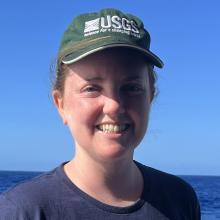
Jane Rudebusch
Tell us about your work/research. What kinds of things do you do?
My job is all about transforming data into visual representation in maps and graphs and analyzing patterns in the geographic distribution of oceanographic phenomena, whether it be water column profiles, deep-sea corals, even cold seeps. I use several computer programs to make 2D and 3D representations of data in order to perform spatial analysis and visual patterns, as well as allow others easier access to our data by creating online web mapping applications for the public to use. I get to work with scientists from a variety of disciplines so there is never a dull moment in the work I do.
What sparked your initial interest in your career?
I have been interested in the ocean from a young age, and was working toward becoming a marine mammal ecologist for much of my early adulthood. It wasn't until I went to graduate school that I learned to use geographic information systems (GIS) and apply the technology for analyzing spatial patterns in data and solving scientific questions that my career path changed.
Who influenced you or encouraged you the most?
My parents and their enduring support of my passion for science and nature from a young age encouraged me to reach beyond what I thought my potential was a huge influence. And my high school Latin teacher for cultivating a love of learning that is one of the most important skills a scientist can have.
What element of your work/study do you think is the most fascinating?
I love the interdisciplinary nature of my work; that observations of biological, physical, chemical, or geological phenomena are linked by a common thread that is their geographic place on earth and that means I get to interact with a lot interesting scientists every day in helping them connect the dots in their data.
How did you get involved with the Ocean Exploration Trust?
I am joining this expedition to assist with the collection and processing of acoustic backscatter data, which will provide us with information about the characteristics of the seafloor in the area we are surveying and will later be used by my colleagues to plan follow-up expeditions to this region for more targeted sampling.
What other jobs led you to your current career?
Prior to my current role I spent several years as a field biologist, which led to some pretty unique and incredible experiences. I have spent time in remote British Columbia tracking the feeding habits of gray whales in fjords, tromping through dense old growth forests in the Oregon coast range monitoring the nests of a tiny and endangered seabird, and much time closer to home here studying the habitat use and feeding ecology of southern sea otters in the Monterey Bay. This led me to pursue my master's degree, during which I learned how to work with spatial data and perform geospatial analysis, and publish my research which is currently being used to inform the feasibility of reintroducing sea otters to their historic home range in San Francisco Bay in the face of modern day anthropogenic pressures. Both during and shortly after graduate school, I also taught several undergraduate biology courses at the university. This combination of field, technical, and teaching experience was an excellent and well-rounded education in science and science communication.
What are your degrees and certifications?
Bachelor of Science in General Science -- University of Oregon 2014; Master of Science in Marine Science -- San Francisco State University 2019; Certificate in Geographic Information Systems (GIS) -- San Francisco State University 2020
What are your hobbies?
I enjoy swimming and riding my horse, and as an avid birder I'm never too far from my binoculars especially during fall and spring migration.
What advice would you give someone who wants to have a career like yours?
The use geographic information systems (GIS) is widespread in scientific fields today and the applications of this technology are endless. Mastering a technical skill, such as GIS or coding, combined with practical or hands on experience in your area of interest can be a real advantage. But the best piece of advice that was given to me, and that I now pass on to every young person looking to get in to marine biology or a similar field, is not to get too specialized too soon. Keeping your interests more broad means you are leaving yourself open to more opportunities which is important in such a highly competitive field and it means that when one door opens, you'll be ready to jump at the chance to explore it! Even if it is not something you saw yourself doing, you might just be surprised at what you find.
Expeditions
Jane participated in the following Ocean Exploration Trust expeditions:
